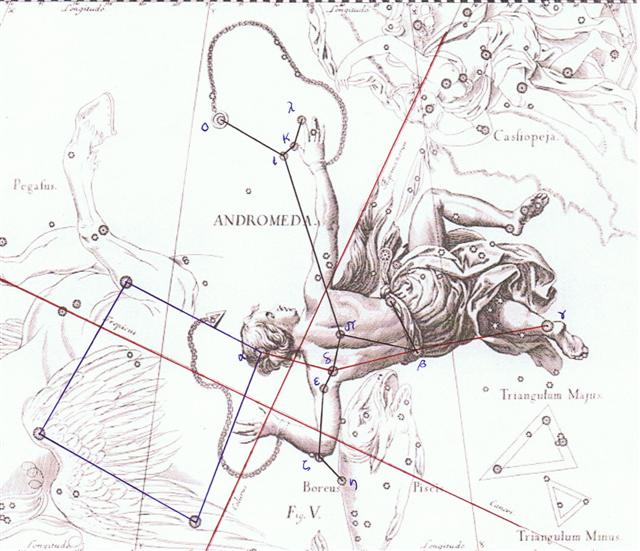Turning the tablet around ought to be accompanied with some kind of basic change. But this is far from evident, because the first 3 glyphs are like those at the end of side a. The intention was rather to underline the continuity from side a:
| April 17 (107) |
18 |
19 |
| October 17 (290) |
18 |
19 |
 |
 |
 |
| Cb1-1 (393) |
Cb1-2 |
Cb1-3 |
| E tupu - ki roto |
o te hau tea |
| Al Sharatain-1 / Ashvini-1 / Bond-16 |
ι Arietis (28.0), λ Arietis (28.2) |
Alrisha, χ Phoenicis (29.2), Alamak (29.7) |
| Segin, Mesarthim, ψ Phoenicis (27.2), SHERATAN, φ Phoenicis (27.4) |
| Muphrid (210.1), ζ Centauri (210.3) |
φ Centauri (211.0), υ¹ Centauri (211.1), υ² Centauri (211.8), τ Virginis (211.9) |
Agena (212.1), θ Apodis (212.5), Thuban (212.8) |
Alamak is γ Andromeda and the last of her great stars to rise:

Below Alamak was the pair of triangles (although there was only one in Mesopotamian times), with Metallah (α Trianguli) rising at the same time as Polaris and Baten Kaitos:
| April 11 |
12 (468) |
13 |
14 |
15 |
16 (106) |
| October 11 |
12 (285) |
13 |
14 |
15 |
16 (289) |
 |
 |
 |
 |
 |
 |
| *Ca14-24 |
*Ca14-25 |
*Ca14-26 |
*Ca14-27 |
*Ca14-28 |
*Ca14-29 |
| te henua |
te honu kau |
manu kake rua |
te henua |
te honu |
te rima |
| δ Phoenicis (21.5) |
no star listed (22) |
Achernar (23.3) |
no star listed (24) |
no star listed (25) |
POLARIS, Baten Kaitos (26.6), Metallah (26.9) |
| no star listed (204) |
Heze (205.0) |
ε Centauri (206.3) |
no star listed (207) |
τ Bootis (208.2), Benetnash (208.5), ν Centauri (208.7), μ Centauri, υ Bootis (208.8) |
no star listed (209) |
The Mesopotamian constellation mulApin (the Plow) included Alamak and it was their time for opening up the earth with new furrows, a fresh new land with as yet life only potentially present.

Metoro said e tupu ki roto ('pregnant inside'), which reminds us of his words at the March equinox, 27 days earlier:
| March 19 |
20 |
21 (80) |
22 |
23 (448) |
| September 18 (261) |
19 |
20 |
21 |
22 (equinox) |
 |
 |
 |
 |
 |
| *Ca14-1 |
*Ca14-2 |
*Ca14-3 (366) |
*Ca14-4 |
*Ca14-5 |
| Kua tupu te ata i te henua |
| η Tucanae (363.0), 32 Piscium (363.2, ψ Pegasi (363.1), π Phoenicis (363.4), ε Tucanae (363.6), τ Phoenicis (363.9) |
no star listed (364) |
Al Fargh al Thāni-25 |
Uttara Bhādrapadā-27 / Wall-14 |
χ Pegasi (2.1), θ Andromedae (2.7) |
| 0h (365.25) |
| Caph, SIRRAH (0.5), ε Phoenicis (0.8) |
ALGENIB PEGASI (1.8) |
| no star listed (181) |
12h (182.6) |
Alchita, Ma Wei (183.1), Minkar (183.7), ρ Centauri (183.9) |
Pálida (184.6), Megrez (184.9) |
Hasta-13 / Chariot-28 |
| π Virginis (182.0), ο Virginis (182.1). θ Crucis (182.5) |
GIENAH (185.1), ε Muscae (185.2). ζ Crucis (185.4), Zaniah (185.9) |
| Tupu 1. Shoot, sprout, bud; to sprout, to bud. 2. Pregnant: vî'e tupu (o te poki); to be conceived (of fetus in its mother's womb): he-tupu te poki i roto i te kopú o toona matu'a. Vanaga.
To grow, to sprout, to germinate, to come forth, to conceive, pregnant, germ; mea tupu, plant; tupu ke avai, of rapid growth; tupu horahorau, precocious; hakatupu, to produce, to stimulate growth, to excite. P Pau.: fakatupu, to raise up, to create. Mgv.: tupu, to grow, to conceive, to be pregnant. Mq.: tupu, to grow, to sprout, to conceive. Ta.: tupu, to grow, to sprout. Churchill.
Mgv.: Tupu, the best or worst |
In rongorongo times the precession had moved the stars of Al Sharatain ahead with ca 27 * 71 = 1917 years since the day when they were at 0h, i.e. according to my estimate around 76 BC (= 1842 AD - 1917). Whereas side a was beginning in the present, the back side was beginning far back in time.
|




